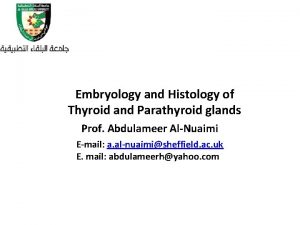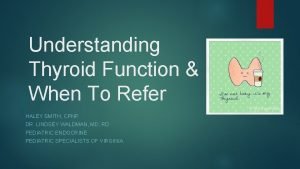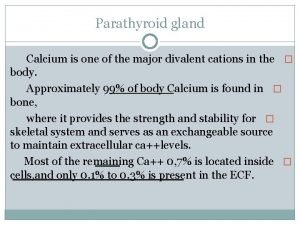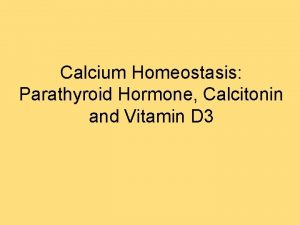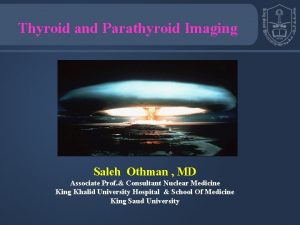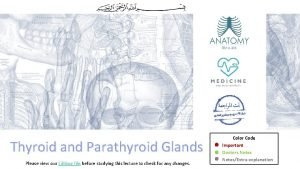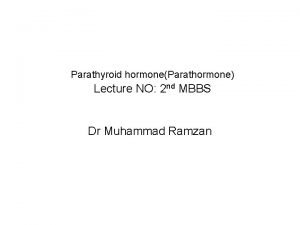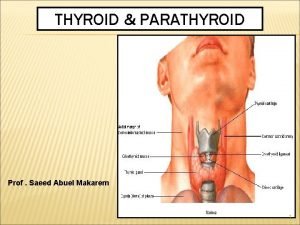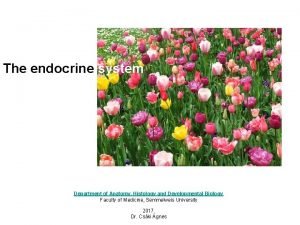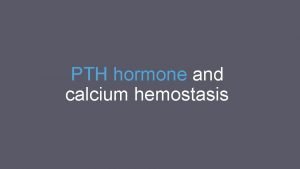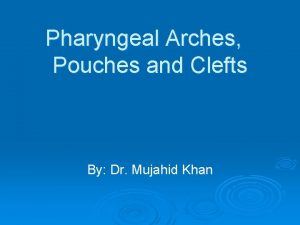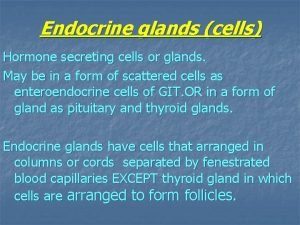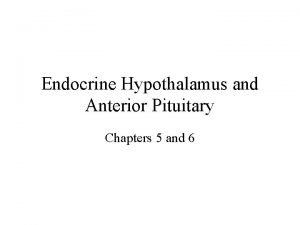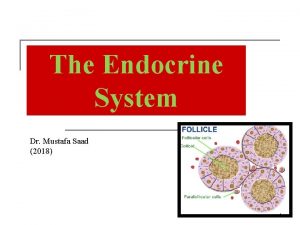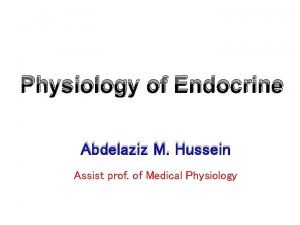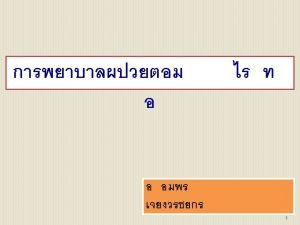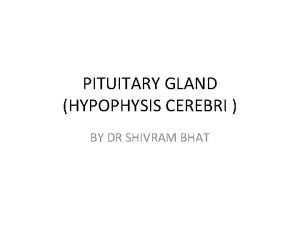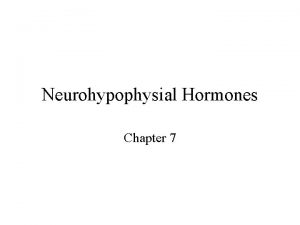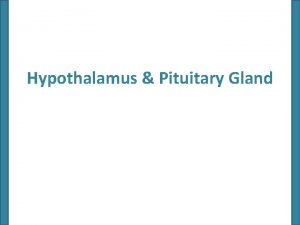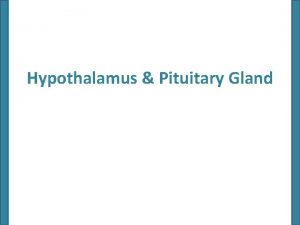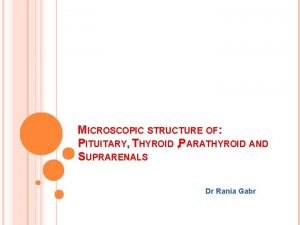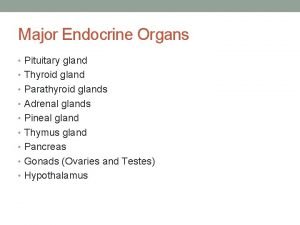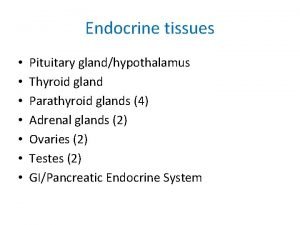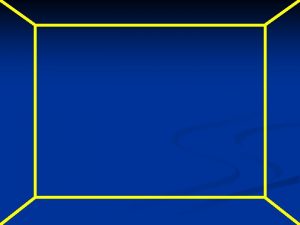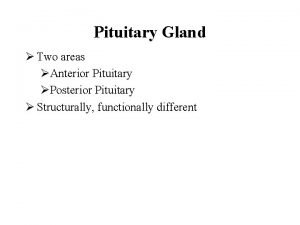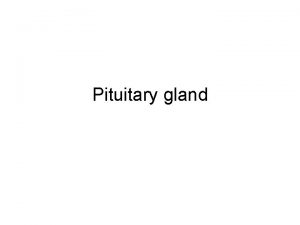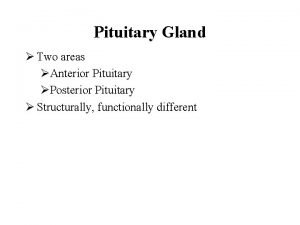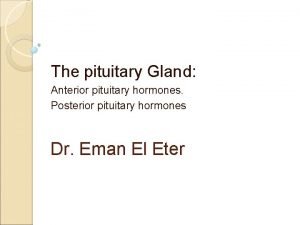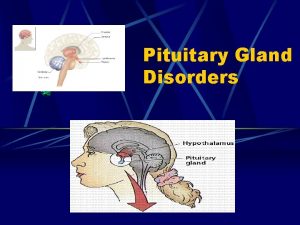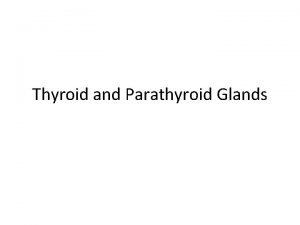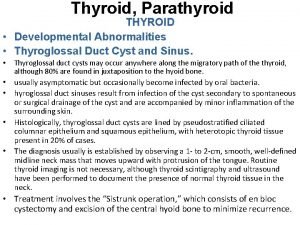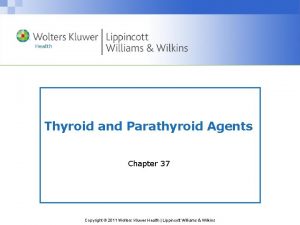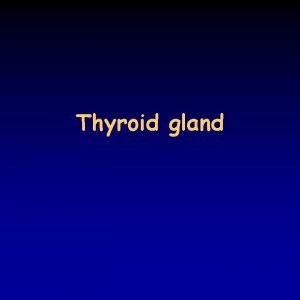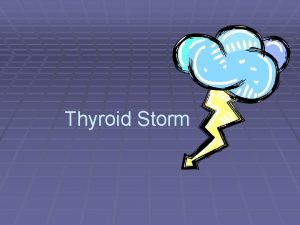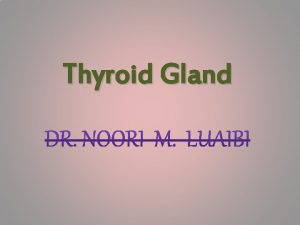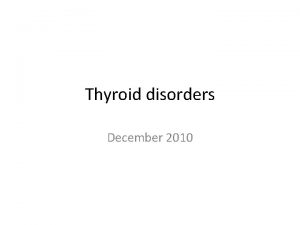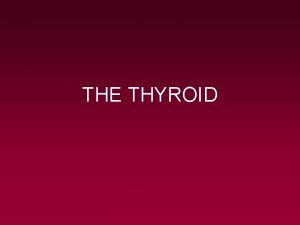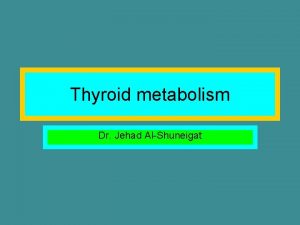Chapter 35 Agents Affecting Thyroid Parathyroid and Pituitary























- Slides: 23

Chapter 35 Agents Affecting Thyroid, Parathyroid, and Pituitary Function

Agents Affecting Thyroid, Parathyroid, and Pituitary Function Goal: maintenance of physiologic stability Hypothalamus and the pituitary gland l l £ £ Form the neuroendocrine system Main director is the hypothalamus 2 Copyright 2007 Thomson Delmar Learning, a division of Thomson Learning Inc. All rights reserved.

Pituitary Gland Consists of: l £ £ Adenohypophysis (anterior pituitary) Neurohypophysis (posterior pituitary) Linked to the hypothalamus Pituitary gland secretes hormones l l 3 (continues) Copyright 2007 Thomson Delmar Learning, a division of Thomson Learning Inc. All rights reserved.

(continued) Hormones secreted by the anterior pituitary 4 Copyright 2007 Thomson Delmar Learning, a division of Thomson Learning Inc. All rights reserved.

Pituitary and Thyroid Glands Pituitary gland l £ Thyroid-stimulating hormone (TSH) Thyroid gland location: neck l £ Produces T 3 and T 4 hormones u £ Cellular metabolism Produces calcitonin u Inhibits bone resorption 5 Copyright 2007 Thomson Delmar Learning, a division of Thomson Learning Inc. All rights reserved.

Thyroid Disorders Hyperthyroidism Hypothyroidism l l 6 Copyright 2007 Thomson Delmar Learning, a division of Thomson Learning Inc. All rights reserved.

Hyperthyroidism Excessive secretion of thyroid hormones l £ 7 Increased metabolism (continues) Copyright 2007 Thomson Delmar Learning, a division of Thomson Learning Inc. All rights reserved.

(continued) Hyperthyroidism Clinical signs and symptoms l £ £ £ £ Skin hot and dry Increased cardiac and respiratory rates Weight loss Increased appetite Muscle weakness Nervousness Irritability Unable to sleep well 8 Copyright 2007 Thomson Delmar Learning, a division of Thomson Learning Inc. All rights reserved.

Antithyroid Drugs Inhibits coupling of iodine l £ Prevent T 3 and T 4 formation Iodides l £ Stop thyrotropin from being active u Inhibits the production of T 3 and T 4 Radioactive isotopes l £ Diagnose and treat hyperthyroidism u 9 Radiation destroys the thyroid gland (continues) Copyright 2007 Thomson Delmar Learning, a division of Thomson Learning Inc. All rights reserved.

(continued) Antithyroid Drugs Methimazole and propyithiouracil (PTU) Side effects/adverse effects l l £ Liver and bone marrow toxicity Interactions l £ £ Increased activity of oral anticoagulants Additive agranulocytosis when taken with bone marrow depressants Therapeutic results l £ Normal metabolic rate 10 Copyright 2007 Thomson Delmar Learning, a division of Thomson Learning Inc. All rights reserved.

Hypothyroidism Decreased secretion of thyroid hormones l £ Decreased metabolism Clinical signs and symptoms l £ £ £ 11 Thickened skin Decreased cardiac and respiratory rates Weight gain Loss of appetite, anorexia Muscle weakness Lethargy (continues) Copyright 2007 Thomson Delmar Learning, a division of Thomson Learning Inc. All rights reserved.

(continued) Hypothyroidism Called cretinism in children l £ £ £ Underdeveloped growth rate Low metabolic rate Mental retardation Called myxedema in adults l £ £ 12 Low metabolic rate Loss of mental and physical stamina Hair loss Firm edema (continues) Copyright 2007 Thomson Delmar Learning, a division of Thomson Learning Inc. All rights reserved.

(continued) Hypothyroidism Goal is to replace thyroid hormone l £ Levothyroxine sodium (Synthroid) Widely prescribed synthetic thyroid hormone l 13 (continues) Copyright 2007 Thomson Delmar Learning, a division of Thomson Learning Inc. All rights reserved.

(continued) Hypothyroidism Thyroid (levothyroxine sodium) preparations Cause interactions l l £ Oral anticoagulants: increased anticoagulant effect u u Digitalis: decreased serum levels Hypoglycemic agents: decreased effect 14 Copyright 2007 Thomson Delmar Learning, a division of Thomson Learning Inc. All rights reserved.

Client Teaching Tips General client teaching tips for clients with thyroid disorders l £ £ £ 15 Too high of a dose will result in nervousness, irritability, and insomnia Keep a log of pulse, weight, and mood status Avoid foods high in iodine such as soy, tofu, turnips, seafood, and iodized salt (continues) Copyright 2007 Thomson Delmar Learning, a division of Thomson Learning Inc. All rights reserved.

(continued) Client Teaching Tips £ £ Immediately report chest pain. Synthroid takes several weeks to months to reach therapeutic level. 16 Copyright 2007 Thomson Delmar Learning, a division of Thomson Learning Inc. All rights reserved.

Parathyroid Glands Parathyroid l £ Pinhead-sized structures located on either side of the thyroid gland Primary function l £ Parathormone secretion u It promotes bone resorption (breakdown of the bone) 17 Copyright 2007 Thomson Delmar Learning, a division of Thomson Learning Inc. All rights reserved.

Hypoparathyroidism Parathormone deficiency Result l l £ £ Decreased blood levels of calcium Increased phosphate levels Neuromuscular irritability Psychiatric disorders Treatment l £ Replace the calcium 18 Copyright 2007 Thomson Delmar Learning, a division of Thomson Learning Inc. All rights reserved.

Hyperparathyroidism Oversecretion of parathormone Result l l £ £ £ Increased blood levels of calcium Decreased phosphate levels Kidney stones Treatment l £ £ Replace the calcitonin Replace the phosphate 19 Copyright 2007 Thomson Delmar Learning, a division of Thomson Learning Inc. All rights reserved.

Pituitary Disorders Hypopituitarism l £ Underproduction of pituitary hormones Therapy l £ £ £ 20 Corticosteroids: a life and death issue Thyroid replacement Sex hormone replacement (continues) Copyright 2007 Thomson Delmar Learning, a division of Thomson Learning Inc. All rights reserved.

(continued) Pituitary Disorders Hyperpituitarism l £ £ Overproduction of pituitary hormones Signs and symptoms: gigantism and acromegaly Treatment l £ £ £ 21 Chemotherapy Radiation Surgery—inactivation or removal (continues) Copyright 2007 Thomson Delmar Learning, a division of Thomson Learning Inc. All rights reserved.

(continued) Pituitary Disorders Diabetes insipidus l £ £ Caused by a deficiency or total absence of vasopressin (ADH) Signs and symptoms u u £ Huge urine output (polyuria) Increased thirst (polydipsia) Hypernatremia (increased sodium) Dehydration Treatment: antidiuretic hormone 22 Copyright 2007 Thomson Delmar Learning, a division of Thomson Learning Inc. All rights reserved.

Antidiuretic Hormone (ADH) Directs the body to retain water and sodium l £ Focus is on water versus sodium Causes vasoconstriction Synthetic ADH drugs l l £ £ Lypressin Vasopressin 23 Copyright 2007 Thomson Delmar Learning, a division of Thomson Learning Inc. All rights reserved.
 Kocher vein
Kocher vein Histological structure of parathyroid gland
Histological structure of parathyroid gland Hashitoxicosis
Hashitoxicosis Parathyroid gland image
Parathyroid gland image Function of calcitonin
Function of calcitonin Thyroid scan
Thyroid scan Pyramidal lobe
Pyramidal lobe Parathyroid hormone
Parathyroid hormone Superior thyroid artery is a branch of
Superior thyroid artery is a branch of Zona glomerulosa produces
Zona glomerulosa produces Surfaces of thyroid gland
Surfaces of thyroid gland Parathyroid hormone pathway
Parathyroid hormone pathway Lateral pharyngeal pouch
Lateral pharyngeal pouch Hypophseal
Hypophseal Difference between anterior and posterior pituitary
Difference between anterior and posterior pituitary Hypophyseal fossa and pituitary gland
Hypophyseal fossa and pituitary gland Hypophyseal fossa and pituitary gland
Hypophyseal fossa and pituitary gland Pituitary gland and pineal gland spiritual
Pituitary gland and pineal gland spiritual Hypophyseal fossa and pituitary gland
Hypophyseal fossa and pituitary gland Pineal and pituitary glands
Pineal and pituitary glands Hypophysis
Hypophysis Difference between anterior and posterior pituitary
Difference between anterior and posterior pituitary Hyposecretion of prolactin
Hyposecretion of prolactin Hypothalamus hormones
Hypothalamus hormones

